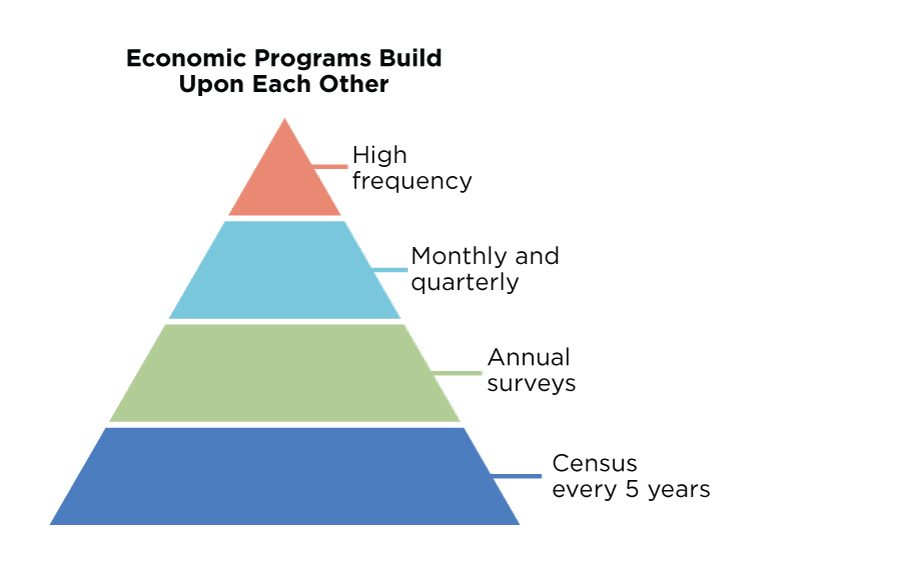Economic Census Will Survey More Than 4 Million Business Locations Starting This Week
Most people know that the U.S. Census Bureau measures the nation’s population once every 10 years. But fewer know that every five years, it conducts another important survey that measures the nation’s businesses to give us a comprehensive measure of U.S. economic activity across more than 21,000 geographic areas.
Letters for the 2022 Economic Census are scheduled to be mailed this week. The letters will explain how business respondents can fill out the 2022 Economic Census questionnaires online.
The 2022 Economic Census is conducted in 2023 but is based on 2022 data.
The economic census serves as the cornerstone of the nation's economic statistics and the information it collects helps shape decisions that affect the health of the economy.
Responses from over 4 million business locations will provide data that paints a more complete picture of U.S. businesses at the national, state and local level.
The statistics it collects will cover 19 economic sectors that encompass 950 North American Industry Classification System (NAICS) industries. Businesses asked to participate should respond by March 15, 2023.
Who Will Receive the 2022 Economic Census?
The economic census does not go to every business. Data from the more than 8 million employer business locations are represented in the economic census, but to reduce burden on the business community, not every business is contacted.
Approximately 4 million business locations will be asked to respond. For the remaining 4 million small businesses, administrative records are used in lieu of direct reporting.
The Economic Census only goes to employer businesses that have paid employees. There is a separate program of Nonemployer Statistics for data on businesses without employees — like independent contractors or the self-employed.
Also, some industries are excluded from the economic census because that data is collected from other federal agencies — agriculture and education, for example.
Cornerstone of Economic Statistics
The economic census serves as the cornerstone of the nation's economic statistics and the information it collects helps shape decisions that affect the health of the economy.
It provides source data for the Gross Domestic Product (GDP), national income and products accounts (NIPAs), the producer price index (PPI), and other key indicators of economic performance.
Economic census totals also serve as benchmarks to keep our other surveys accurate. The economic surveys and programs conducted by the Census Bureau are the source of official statistics and the foundation of our national accounts fueled by the data provided by businesses and government.
At the top of the pyramid are our new high-frequency surveys that are released in biweekly phases, such as the Business Trends and Outlook Survey (previously Small Business Pulse Survey) and Business Formation Statistics.
Next, we have monthly and quarterly surveys, which have a small sample size, but provide some of the timeliest data. They provide a snapshot of the economy in a wide range of sectors, such as Monthly Retail Trade, Construction Spending and Quarterly Services Survey.
Then we have the annual surveys that have larger samples and provide some of the most up-to-date detailed trend data available. Examples include the Annual Survey of Manufactures and Annual Business Survey.
Lastly, we collect the economic census every five years, which provides the most comprehensive data available.
The administrative data in our Business Register that we use to supplement or produce economic statistics are the foundation of all these surveys.
The economic census is also used to update the Business Register and without this effort, we would miss vital information about changes in the ownership and organizational structure of U.S. businesses and industries.
Unique Nature of the Economic Census
The economic census offers information on business locations, the workforce, and trillions of dollars of sales by products and services.
One of the ways it differs from other programs is that it collects information by individual business locations, rather than a company total. By reporting sales, payroll and revenue type for each individual location, the data are able to reflect these numbers where the economic activity takes place, producing statistics on local businesses, not just at national or state level.
It collects information on physical location, primary business activity using NAICS codes, employment, payroll, revenue by type of service or product using the North American Product Classification System (NAPCS), and industry specific information.
The economic census statistics about industries, their inputs and outputs, and how they relate to each other, are not available elsewhere.
How the Economic Census Helps Everyone
Why should you care about the economic census if you don’t own a business?
The data produced from the economic census guides business decisions that affect you and the community you live in.
Businesses use economic census data to decide where to locate (impact on services and local economy), how much to produce (impact on employment), and how their business compares to other businesses in their industry or community (impact on improvements).
Local communities use economic census data to attract new businesses, assess the economic health of their localities, understand the characteristics of their business base and compare their community to other areas. Individuals can also use economic census data to identify emerging job markets and growing industries.
Overview of 2022 Economic Census
Related Statistics
-
2022 Economic CensusThe Economic Census is the most comprehensive measure of the U.S. economy, providing industry and market statistics at the national, state, and local levels.
-
Press Kit2022 Economic Census Press KitThe Economic Census is the U.S. government’s official 5-year measure of American businesses and the economy.
-
Stats for StoriesSmall Business Week: April 30-May 6, 2023The 2020 County Business Patterns found that 4.4M of all 8.0M establishments in the U.S. had 1 to 4 employees. Just under 200,000 had 100 employees or more.
-
Stats for StoriesNational Manufacturing Day: October 3, 2025The U.S. Census Bureau joins organizations across the country celebrating the importance of the manufacturing sector of the nation’s economy.
Subscribe
Our email newsletter is sent out on the day we publish a story. Get an alert directly in your inbox to read, share and blog about our newest stories.
Contact our Public Information Office for media inquiries or interviews.
-
America Counts StoryRetail Trade Is the Top Sector in the Five U.S. TerritoriesMarch 10, 2021Recently released data from the Census Bureau’s 2017 Economic Census of Island Areas show economies of these territories mirror the U.S. economy in many ways.
-
America Counts StoryBusinesses Lease Cars, Office Space, Furniture and … WorkersMay 20, 2021The nation’s 3,769 employee-leasing businesses had 2.7 million workers and generated $177.8 billion in revenue in 2017.
-
America Counts StorySales of Warehouse Clubs and Supercenters Grew — or Did They?October 06, 2021The new 2017 Economic Census Comparative Statistics and Bridge Statistics reports ensure apple-to-apple comparisons when industry classifications change.
-
America Counts StoryRVs: A Way to See America From the Safety of Your Own “Home”September 29, 2020Americans embrace recreational vehicles as sales have grown steadily for years.
-
EmploymentThe Stories Behind Census Numbers in 2025December 22, 2025A year-end review of America Counts stories on everything from families and housing to business and income.
-
Families and Living ArrangementsMore First-Time Moms Live With an Unmarried PartnerDecember 16, 2025About a quarter of all first-time mothers were cohabiting at the time of childbirth in the early 2020s. College-educated moms were more likely to be married.
-
Business and EconomyState Governments Parlay Sports Betting Into Tax WindfallDecember 10, 2025Total state-level sports betting tax revenues has increased 382% since the third quarter of 2021, when data collection began.
-
EmploymentU.S. Workforce is Aging, Especially in Some FirmsDecember 02, 2025Firms in sectors like utilities and manufacturing and states like Maine are more likely to have a high share of workers over age 55.





